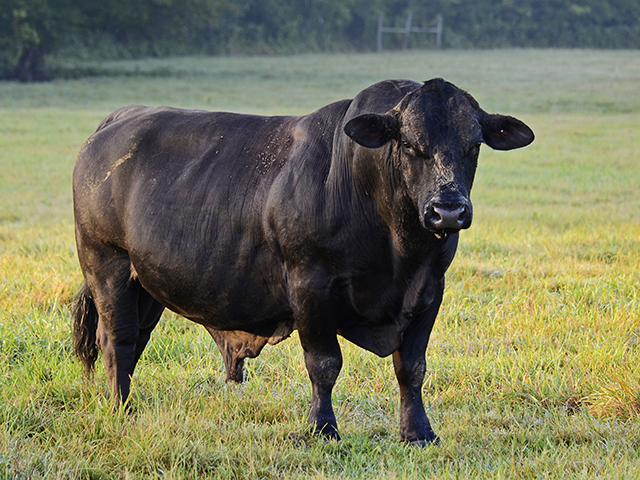Ask the Vet
Bad Day for a Bull
READER: I turned our bull in with the cows, and when I checked on him the next day, his penis was bent down at almost a 90-degree angle after attempting to breed cows. What do you think happened? Can he still breed cows?
Dr. McMillan: There are several possibilities, but let's start by saying your veterinarian needs to examine him soon. He is most likely done for the breeding season, and this situation may not be salvable. This is most likely a penile deviation. It can occur secondary to an injury to the penis that healed with scar tissue creating the deviation. Spontaneous deviations can also occur.
A fibrous ligament runs along the top of the penis and keeps it straight during erection. This ligament can slip off to the side, creating a spiral deviation. If the ligament is weak or stretched, it can create ventral deviation. If the ligament is too short, it can pull the penis into an S shape. Any of these problems can prevent a bull from breeding.
Bulls have a huge economic and genetic impact on a herd. A number of common problems can limit or hinder breeding ability. A preputial prolapse, for example, occurs when the prepuce is torn during breeding or traumatized while partially extended. Briars, brush, wire or junk in pastures can scratch or lacerate the prepuce. It will swell and cannot be fully retracted. The bull often looks like there is a red ball hanging out of the preputial opening. Mild cases may heal with rest and conservative treatment; more severe damage requires surgery.
A hematoma of the penis, or "broken penis," occurs during mating when the fibrous sheath around the penis is torn. Blood leaks out from the vascular tissue and forms a clot. These bulls have a hard swelling just in front of the scrotum. Some bulls can heal with conservative treatment, but surgery is often required.
P[L1] D[0x0] M[300x250] OOP[F] ADUNIT[] T[]
A persistent frenulum is a thin band of tissue connecting the penis to the prepuce of a bull at birth. It normally goes away before they are a year of age. This tissue can pull the penis into a downward curve. It is easily detected during a Breeding Soundness Exam (BSE) and can be corrected with a simple surgery.
Penile hair rings can form from riding activity. In some cases, they constrict and damage the penis, possibly permanently. In most cases, these can be easily removed.
Fibropapillomas, or warts of the penis, are fairly common in young bulls. It's not unusual for these to spread among younger bulls raised together because of riding activity. These can be severe enough to prevent breeding.
Lastly, it's important to add that many of these problems are easily detected during an annual BSE. Every bull, every year. The BSE is one of your best investments.
READER: I raise calves to butcher for family and friends. I have a question about essential amino acids. I know we need to get these into our diets to build muscle. Do animals have essential amino acids? How do they get them?
Dr. McMillan: Amino acids are the building blocks of proteins. These large molecules are made up of carbon, oxygen, hydrogen and nitrogen, and some contain sulfur. There are about 20 different amino acids that combine to make proteins. Essential amino acids, despite their name, are no more important than the others; the term is used for those an animal can't synthesize in its body.
Humans need nine amino acids they cannot manufacture. Cattle, too, have amino acids they cannot manufacture. But, cattle have something we don't: their remarkable rumen. Rumen microbes are very efficient at making amino acids and high-quality protein from forages. Ruminants do not need any supplemental amino acids. But, because of the demands we place on our herds, we often need to supplement carbohydrates, proteins and minerals to reach optimum production levels.
Ruminant nutrition is complex, and we learn more about it all the time. Feed companies produce rations balanced for different production goals, and these rations vary greatly. For example, a starting ration for calves is very different from a finishing ration used in a feedlot.
If you mix your own ration, you have to take different needs into account and consult with a nutritionist. The end product cattle producers provide is a high-quality protein with all nine essential amino acids needed for human growth and maintenance, and the profile is almost identical to that of our own muscles. And, best of all, it tastes great!
**
> Please contact your veterinarian with questions pertaining to the health of your herd. Every operation is unique, and the information in this column does not pertain to all situations. This is not intended as medical advice but is purely for informational purposes.
> Write Dr. Ken McMillan at Ask The Vet, 2204 Lakeshore Dr., Suite 415, Birmingham, AL 35209, or email vet@progressivefarmer.com.
[PF_0321]
(c) Copyright 2021 DTN, LLC. All rights reserved.




